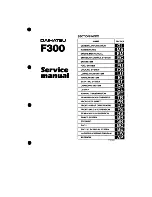
The differential lock for the front axle is
engaged.
Disengaging the differential locks
You can disengage the differential locks in the
following order:
;
,
?
,
=
.
X
To simultaneously disengage all
differential locks: press switch
=
.
Yellow activation indicator lamps
A
and
red function indicator lamps
:
go out.
After approximately three seconds of
normal driving, ABS, 4ETS, ESP
®
and BAS
are activated.
The
ABS
ABS not
not available
available Differential
Differential
Locked
Locked
message disappears in the
multifunction display and the
å
,
!
and
÷
warning lamps in the instrument
cluster go out.
X
Shift the transfer case to the HIGH
RANGE on-road position (
Y
page 130).
i
If red function indicator lamps
:
do not
go out after disengaging the differential
locks, bring the vehicle to a standstill in
accordance with the traffic conditions.
Then continue driving, as the load change
can release the differential locks.
Towing a trailer
Notes on towing a trailer
Important safety notes
G
WARNING
If you rest your foot on the brake pedal while
driving, the braking system can overheat. This
increases the stopping distance and can even
cause the braking system to fail. There is a
risk of an accident.
Never use the brake pedal as a footrest. Never
depress the brake pedal and the accelerator
pedal at the same time.
G
WARNING
When the vehicle/trailer combination begins
to lurch, you could lose control of it. The
vehicle/trailer combination could even
rollover. There is a risk of an accident.
On no account should you attempt to
straighten up the vehicle/trailer combination
by increasing the speed. Reduce vehicle
speed and do not countersteer. Apply the
brake as necessary.
G
WARNING
If you install a ball coupling other than the one
delivered with the vehicle, the trailer tow hitch
and the rear axle may be overloaded. This
applies especially if the ball coupling in
question is longer or angled differently. This
could seriously impair the driving
characteristics and the trailer can come
loose. There is a risk of an accident.
Only install the ball coupling delivered with
the vehicle or a ball coupling that is designed
to meet your trailer towing requirements. Do
not modify the ball coupling or the trailer tow
hitch.
G
WARNING
If the ball coupling is not installed correctly or
not secured with the bolt provided and the
corresponding spring cotter, the trailer may
come loose. There is a risk of an accident.
Always install and secure the ball coupling as
described. Before every journey, ensure that
the ball coupling is secured with the bolt and
the corresponding spring cotter.
Please observe the manufacturer's operating
instructions for the trailer coupling if a
detachable trailer coupling is used.
You will find the applicable permissible
values, which must not be exceeded, in the
vehicle documents. You will find the values
approved by the manufacturer on the vehicle
identification plates and those for the towing
vehicle in the "Technical data" section
(
Y
page 258).
134
Towing a trailer
Driving
and
parking
















































